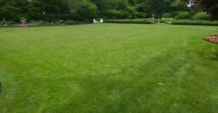Some perennials may spread and take up too much space. Other perennials such as ornamental grass may develop a hole in the middle. This segment demonstrates the process involved in dividing perennials. Doing this every few years will help to rejuvenate them, and you can share the extra plants with friends.
Produced by the Department of Communications at Kansas State University. For more information, visit our website at: http://www.kansasgreenyards.org
Perennials are good plants because you can buy them once and they’ll grow for several years. However, after a few years you may see some changes in them. They may need to be divided so that they will stay vigorous. You may have patches where they are spreading and taking up too much space, so you’ll need to thin them. And, sometimes they’ll die out in the middle. So, if you rejuvenate them every few years, then you can keep that flowerbed looking as nice as when you first planted them.
Springtime is a good time to divide perennials because the roots can establish themselves quickly. They aren’t going through a lot of stress periods. Some plants such as iris and daylilies can be moved in July. Since they go through a resting period, the heat of the summer won’t bother them if they’re moved. But most perennials should be moved in the early springtime or fall to reduce stress for the plant.
Basically, you’re lifting the plants and dividing them into as many sections and you’d like or what is suitable. Mark the spot where the new plant will go, and dig up the soil. The plant should be set down at the same height, as it was earlier. It may need to be set slightly higher if the soil bed has been fluffed, which will settle over the season. So, you’ll need to make sure that the crown or growing point is at the proper location. For most perennials, it’s right at the soil level. However, peonies are usually set one or two inches below grade for ideal blooming periods.
Once you have your plant relocated in the ground, you’ll need to settle the soil by watering the plant. This will help settle the soil around the roots. And, some mulch around the plant will help hold moisture in the soil. It also keeps weeds down, and it helps to moderate the soil temperatures, as the plant is re-established. The mulch will also help in recovering from possible transplanting shock from being moved to a new location.
This feature story prepared with Gregg Eyestone, Kansas State University Research and Extension Horticulture Agent, Riley County. For more information, visit your local county extension office or visit our website at KansasGreenYards.org.




